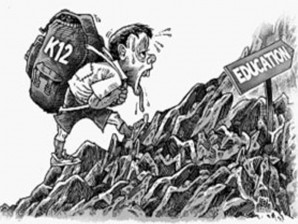Classes start tomorrow for most of Cebu’s students and things aren’t looking up as far as basic necessities are concerned.
The spate of stories about the lack of classrooms in Cebu City due to sloppy work by contractors is the “same old, same old” predicament that both public elementary and high school students find themselves in whenever the school season comes around the corner.
One such story is in barangay Toong, where a Zamboanga del Sur-based contractor had yet to complete repairs on the school building that had an unstable second floor and cracks on the walls and beams.
The Toong school officials aren’t taking any chances and would rather risk holding classes outside, under the shade of trees where pupils will have to take their chances on getting soaked to their skin due to unpredictable weather.
But they may even be considered the more fortunate ones. Elsewhere in some remote hinterland barangay, students have to navigate their way through a river and walk some distance to reach their schools, leaving early in the morning and walking late in the afternoon in a return trip back home.
This is not to say that students in private schools have it easier as the national government seeks to expedite the implementation of the K-12 program that adds a kindergarten year and more high school years to students in order to make them more competitive with the rest of the world.
And we’re not even mentioning about the additional fees being charged every school year as school management seeks to justify the increases to parents who find it more difficult to send their children to private schools and opt to enroll them to public schools instead.
So many problems and not enough is being done to realize the national government’s mandate to provide universal access to education. While the Cebu City government earns props for providing scholarships to its best and brightest, it falls short in providing more adequate school buildings that students can study in.
Vice Mayor Joy Young even tried to justify the city government’s initial reluctance to install more exits and stairways to school buildings by saying this would prove to be more expensive.
This same skewed sense of priorities is also magnified in the national level, where militant youth groups have a point when they called on the government to spend less on arms to protect the country from the China incursions in the Spratlys and more on education.
While building more classrooms remains an ongoing target, perhaps the national and local governments should plan on subsidizing schooling to their youth constituents at least until after high school similar to the US.
For now though, local officials would do well to focus on providing the necessary school infrastructure like school buildings that can be studied in.
